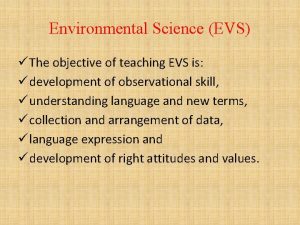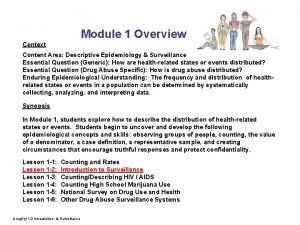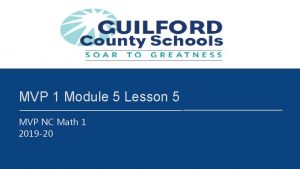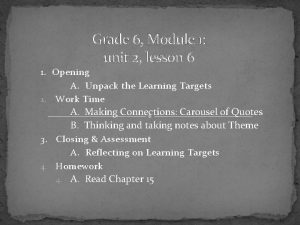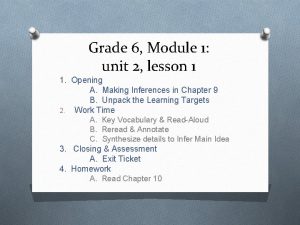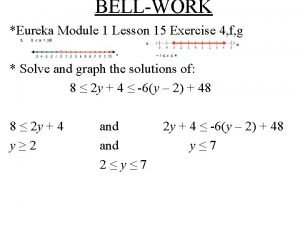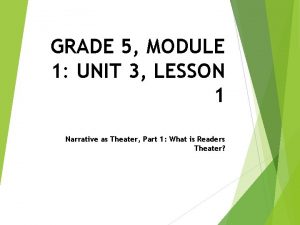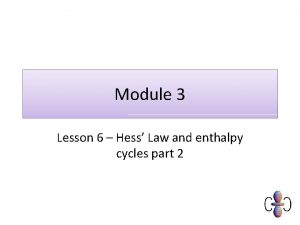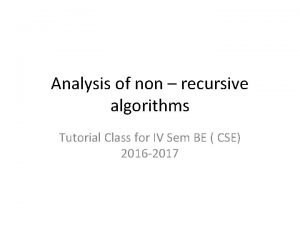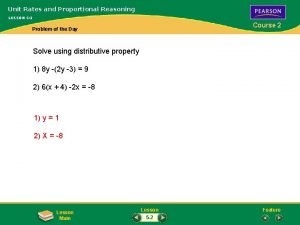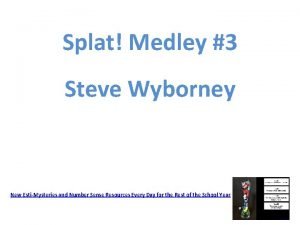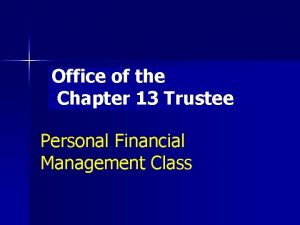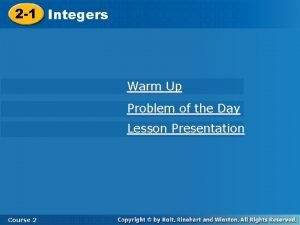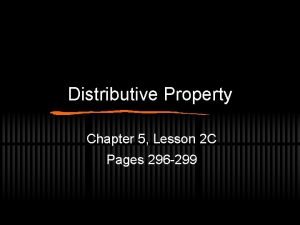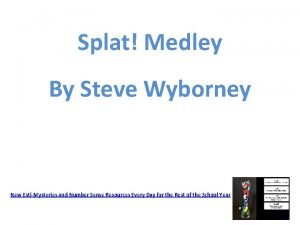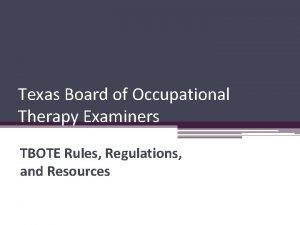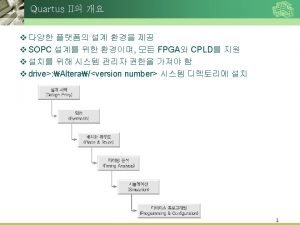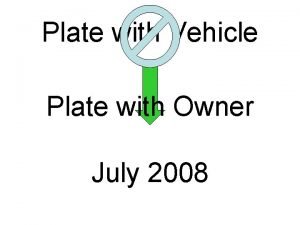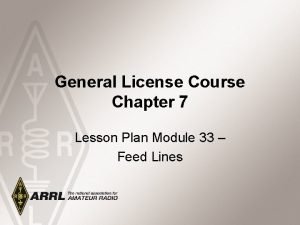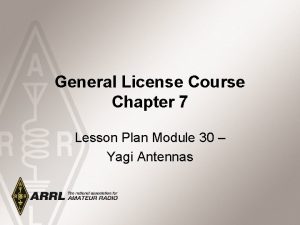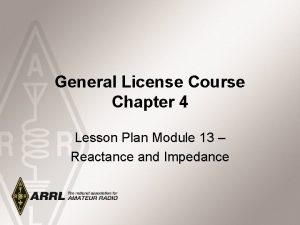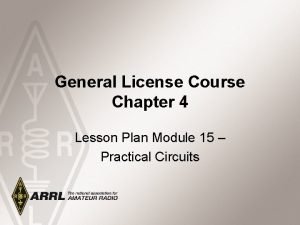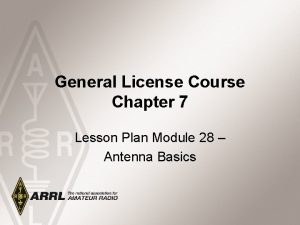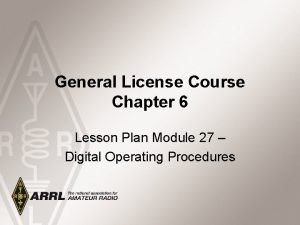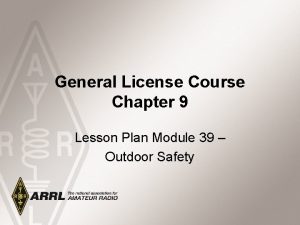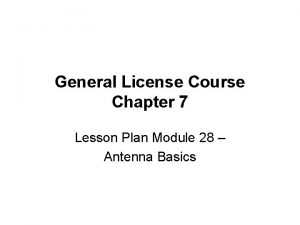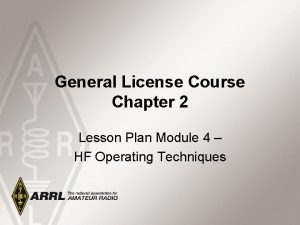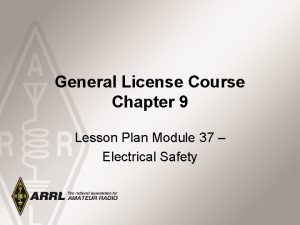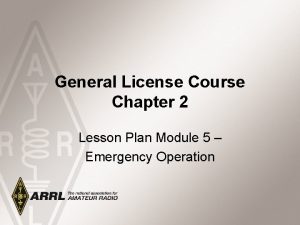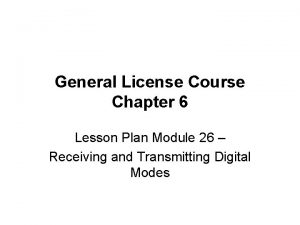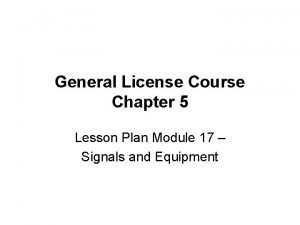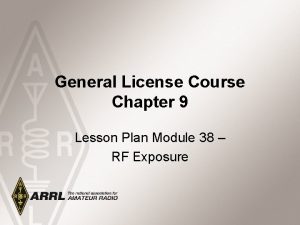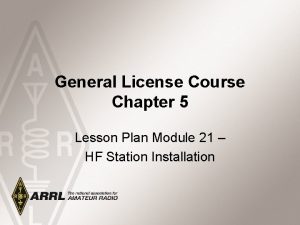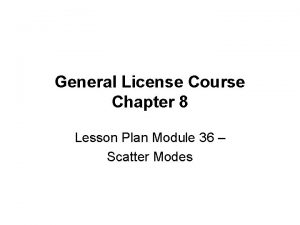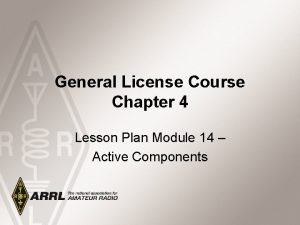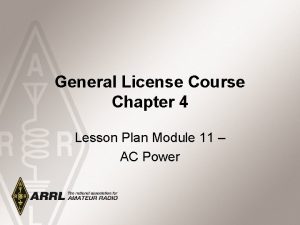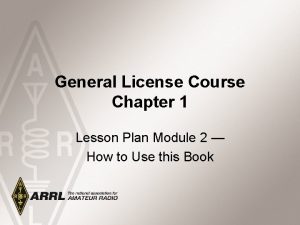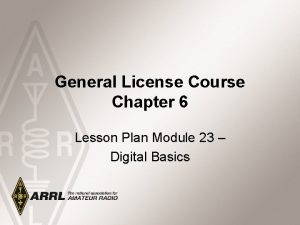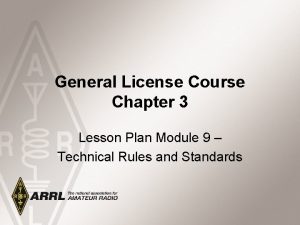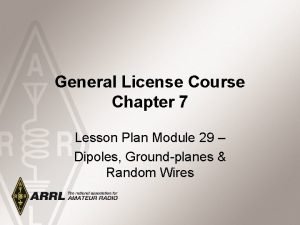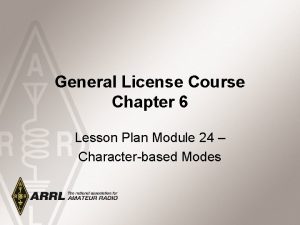General License Course Chapter 5 Lesson Plan Module




















































- Slides: 52

General License Course Chapter 5 Lesson Plan Module 20 – Receiver Structure

Superheterodyne Receivers • Received signals are incredibly weak – on the order of nano or picowatts 2015 General License Course 2

Superhet Receiver • Received signals are first boosted by the RF amplifier, then applied to the RF input of a mixer • The local oscillator (LO) is adjusted so that the desired signal creates a mixing product at the intermediate frequency (IF) • A detector or demodulator stage follows the IF to recover the modulating information 2015 General License Course 3

Simplest Superhet • The simplest possible superhet consists of a mixer connected to the antenna, an HF oscillator to act as an LO, and a detector that operates directly on the resulting IF signal • Once amplified to a more usable level, SSB and CW signals are demodulated by a product detector • A type of mixer that combines the IF signal with the output of a beat frequency oscillator (BFO) to produce an audio frequency mixing product 2015 General License Course 4

Superhet Receiver • The receiver’s front end is made up of the RF amplifier (if any) and the first mixer • A preamplifier is used for weak signals • A preselector is an RF filter to remove strong out of band signals • In an FM receiver the linear IF amplifier is replaced by a limiter. • A discriminator or a quadrature detector replaces the product detector 2015 General License Course 5

Doing the Math • Example: If the IF is 455 k. Hz and the LO frequency is 13. 800 MHz, signals at both 14. 255 and 13. 345 MHz will create a mixing product at 455 k. Hz • Assuming the receiver is supposed to receive the 14. 255 MHz signal, the undesired signal at 13. 345 MHz is called an image • Filters in the RF Front End remove signals at image frequencies to eliminate this source of interfering signals. 2015 General License Course 6

Superhet Receiver • Superhet receivers may have one, two, or three IF stages, resulting in a single-, double-, or triple-conversion receiver • Filters are applied at each IF to remove unwanted signals and noise • Filters improve signal quality with the lowest unwanted noise and interference, maximizing the signal-to-noise ratio (SNR) 2015 General License Course 7

Digital Signal Processing • The general term for converting signals from analog to digital form, operating on them with a microprocessor, and converting them back to analog is digital signal processing (DSP) 2015 General License Course 8

SDR • Some transceivers have so much of their functions implemented by DSP that the entire structure can be changed by running different software • These radios are referred to as SDR, for software-defined radios • SDR is rapidly becoming the dominant technology in high-performance transceivers 2015 General License Course 9

Common DSP Functions • Signal filtering – offers selectable preprogrammed filters and adjustable filter bandwidth and shape, such as notch filters • Noise reduction – DSP can distinguish and remove some kinds of noise, leaving only the desired speech or CW for the operator to copy • Audio frequency equalization – Adjustable receive or transmit audio frequency response to suit preferences 2015 General License Course 10

Common DSP Functions • Notch filtering – Interfering signals in the receiver’s passband, particularly carriers from broadcast stations, can be sensed and removed by DSP • An automatic notch filter can track interfering signals as they change frequency and eliminate more than one at a time 2015 General License Course 11

RF Gain Control • Set the RF gain control to maximum for the highest receiver sensitivity • Lower values of RF gain reduces background noise and helps prevent receiver overload • Maximum sensitivity may not be the best • The automatic gain control (AGC) circuits vary the gain of the RF and IF amplifiers so that the output volume of a signal stays relatively constant for both weak and strong signals 2015 General License Course 12

S Meter • The AGC circuit adjusts receiver gain by changing a voltage that controls the RF and IF amplifier gain • The voltage is read by the S meter of the receiver, which is used to measure received signal strength • “S” stands for “signal” 2015 General License Course 13

S Meter • S meters are calibrated in S units, equal to 6 d. B change per S unit • S 9 is at the midpoint of the S meter display – good signal • Additional markings 20, 40, and 60 correspond to d. B above S 9 • A reading of S 9 + 20 d. B, therefore corresponds to a signal 20 d. B (100 times) stronger than an S 9 signal 2015 General License Course 14

Receiver Linearity • If the received signal is distorted, spurious signals will appear just as if a transmitting station were emitting them • The most common form of receiver nonlinearity is caused by front-end overload • The attenuator and RF gain controls can reduce received noise and distortion caused by strong signals 2015 General License Course 15

Practice Questions 2015 General License Course

Which of the following is a use for the IF shift control on a receiver? A. To avoid interference from stations very close to the receive frequency B. To change frequency rapidly C. To permit listening on a different frequency from that on which you are transmitting D. To tune in stations that are slightly off frequency without changing your transmit frequency G 4 A 11 2015 General License Course

Which of the following is a use for the IF shift control on a receiver? A. To avoid interference from stations very close to the receive frequency B. To change frequency rapidly C. To permit listening on a different frequency from that on which you are transmitting D. To tune in stations that are slightly off frequency without changing your transmit frequency G 4 A 11 2015 General License Course

What is one reason to use the attenuator function that is present on many HF transceivers? A. To reduce signal overload due to strong incoming signals B. To reduce the transmitter power when driving a linear amplifier C. To reduce power consumption when operating from batteries D. To slow down received CW signals for better copy G 4 A 13 2015 General License Course

What is one reason to use the attenuator function that is present on many HF transceivers? A. To reduce signal overload due to strong incoming signals B. To reduce the transmitter power when driving a linear amplifier C. To reduce power consumption when operating from batteries D. To slow down received CW signals for better copy G 4 A 13 2015 General License Course

Which of the following is a function of a digital signal processor? A. To provide adequate grounding B. To remove noise from received signals C. To increase antenna gain D. To increase antenna bandwidth G 4 C 11 2015 General License Course

Which of the following is a function of a digital signal processor? A. To provide adequate grounding B. To remove noise from received signals C. To increase antenna gain D. To increase antenna bandwidth G 4 C 11 2015 General License Course

Which of the following is an advantage of a receiver DSP IF filter as compared to an analog filter? A. A wide range of filter bandwidths and shapes can be created B. Fewer digital components are required C. Mixing products are greatly reduced D. The DSP filter is much more effective at VHF frequencies G 4 C 12 2015 General License Course

Which of the following is an advantage of a receiver DSP IF filter as compared to an analog filter? A. A wide range of filter bandwidths and shapes can be created B. Fewer digital components are required C. Mixing products are greatly reduced D. The DSP filter is much more effective at VHF frequencies G 4 C 12 2015 General License Course

Which of the following can perform automatic notching of interfering carriers? A. Bandpass tuning B. A Digital Signal Processor (DSP) filter C. Balanced mixing D. A noise limiter G 4 C 13 2015 General License Course

Which of the following can perform automatic notching of interfering carriers? A. Bandpass tuning B. A Digital Signal Processor (DSP) filter C. Balanced mixing D. A noise limiter G 4 C 13 2015 General License Course

What does an S meter measure? A. Conductance B. Impedance C. Received signal strength D. Transmitter power output G 4 D 04 2015 General License Course

What does an S meter measure? A. Conductance B. Impedance C. Received signal strength D. Transmitter power output G 4 D 04 2015 General License Course

How does a signal that reads 20 d. B over S 9 compare to one that reads S 9 on a receiver, assuming a properly calibrated S meter? A. It is 10 times less powerful B. It is 20 times less powerful C. It is 20 times more powerful D. It is 100 times more powerful G 4 D 05 2015 General License Course

How does a signal that reads 20 d. B over S 9 compare to one that reads S 9 on a receiver, assuming a properly calibrated S meter? A. It is 10 times less powerful B. It is 20 times less powerful C. It is 20 times more powerful D. It is 100 times more powerful G 4 D 05 2015 General License Course

Where is an S meter found? A. In a receiver B. In an SWR bridge C. In a transmitter D. In a conductance bridge G 4 D 06 2015 General License Course

Where is an S meter found? A. In a receiver B. In an SWR bridge C. In a transmitter D. In a conductance bridge G 4 D 06 2015 General License Course

How much must the power output of a transmitter be raised to change the S meter reading on a distant receiver from S 8 to S 9? A. Approximately 1. 5 times B. Approximately 2 times C. Approximately 4 times D. Approximately 8 times G 4 D 07 2015 General License Course

How much must the power output of a transmitter be raised to change the S meter reading on a distant receiver from S 8 to S 9? A. Approximately 1. 5 times B. Approximately 2 times C. Approximately 4 times D. Approximately 8 times G 4 D 07 2015 General License Course

What circuit is used to process signals from the RF amplifier and local oscillator then send the result to the IF filter in a superheterodyne receiver? A. Balanced modulator B. IF amplifier C. Mixer D. Detector G 7 C 03 2015 General License Course

What circuit is used to process signals from the RF amplifier and local oscillator then send the result to the IF filter in a superheterodyne receiver? A. Balanced modulator B. IF amplifier C. Mixer D. Detector G 7 C 03 2015 General License Course

What circuit is used to combine signals from the IF amplifier and BFO and send the result to the AF amplifier in some single sideband receivers? A. RF oscillator B. IF filter C. Balanced modulator D. Product detector G 7 C 04 2015 General License Course

What circuit is used to combine signals from the IF amplifier and BFO and send the result to the AF amplifier in some single sideband receivers? A. RF oscillator B. IF filter C. Balanced modulator D. Product detector G 7 C 04 2015 General License Course

What is the simplest combination of stages that implement a superheterodyne receiver? A. RF amplifier, detector, audio amplifier B. RF amplifier, mixer, IF discriminator C. HF oscillator, mixer, detector D. HF oscillator, prescaler, audio amplifier G 7 C 07 2015 General License Course

What is the simplest combination of stages that implement a superheterodyne receiver? A. RF amplifier, detector, audio amplifier B. RF amplifier, mixer, IF discriminator C. HF oscillator, mixer, detector D. HF oscillator, prescaler, audio amplifier G 7 C 07 2015 General License Course

What type of circuit is used in many FM receivers to convert signals coming from the IF amplifier to audio? A. Product detector B. Phase inverter C. Mixer D. Discriminator G 7 C 08 2015 General License Course

What type of circuit is used in many FM receivers to convert signals coming from the IF amplifier to audio? A. Product detector B. Phase inverter C. Mixer D. Discriminator G 7 C 08 2015 General License Course

Which of the following is needed for a Digital Signal Processor IF filter? A. An analog to digital converter B. A digital to analog converter C. A digital processor chip D. All of these choices are correct G 7 C 09 2015 General License Course

Which of the following is needed for a Digital Signal Processor IF filter? A. An analog to digital converter B. A digital to analog converter C. A digital processor chip D. All of these choices are correct G 7 C 09 2015 General License Course

How is Digital Signal Processor filtering accomplished? A. By using direct signal phasing B. By converting the signal from analog to digital and using digital processing C. By differential spurious phasing D. By converting the signal from digital to analog and taking the difference of mixing products G 7 C 10 2015 General License Course

How is Digital Signal Processor filtering accomplished? A. By using direct signal phasing B. By converting the signal from analog to digital and using digital processing C. By differential spurious phasing D. By converting the signal from digital to analog and taking the difference of mixing products G 7 C 10 2015 General License Course

What is meant by the term “software defined radio” (SDR)? A. A radio in which most major signal processing functions are performed by software B. A radio that provides computer interface for automatic logging of band frequency C. A radio that uses crystal filters designed using software D. A computer model that can simulate performance of a radio to aid in the design process G 7 C 11 2015 General License Course

What is meant by the term “software defined radio” (SDR)? A. A radio in which most major signal processing functions are performed by software B. A radio that provides computer interface for automatic logging of band frequency C. A radio that uses crystal filters designed using software D. A computer model that can simulate performance of a radio to aid in the design process G 7 C 11 2015 General License Course

If a receiver mixes a 13. 800 MHz VFO with a 14. 255 MHz received signal to produce a 455 k. Hz intermediate frequency (IF) signal, what type of interference will a 13. 345 MHz signal produce in the receiver? A. Quadrature noise B. Image response C. Mixer interference D. Intermediate interference G 8 B 02 2015 General License Course

If a receiver mixes a 13. 800 MHz VFO with a 14. 255 MHz received signal to produce a 455 k. Hz intermediate frequency (IF) signal, what type of interference will a 13. 345 MHz signal produce in the receiver? A. Quadrature noise B. Image response C. Mixer interference D. Intermediate interference G 8 B 02 2015 General License Course

Why is it good to match receiver bandwidth to the bandwidth of the operating mode? A. It is required by FCC rules B. It minimizes power consumption in the receiver C. It improves impedance matching of the antenna D. It results in the best signal to noise ratio G 8 B 09 2015 General License Course

Why is it good to match receiver bandwidth to the bandwidth of the operating mode? A. It is required by FCC rules B. It minimizes power consumption in the receiver C. It improves impedance matching of the antenna D. It results in the best signal to noise ratio G 8 B 09 2015 General License Course
 Micro teaching lesson plan for english
Micro teaching lesson plan for english Objective of evs
Objective of evs C device module module 1
C device module module 1 A supervisor's guide to safety leadership
A supervisor's guide to safety leadership Course module sample
Course module sample Pati explain to tapi that the beggar
Pati explain to tapi that the beggar One and a half brick wall
One and a half brick wall Course number and title
Course number and title Chaine parallèle muscle
Chaine parallèle muscle Ahrs army
Ahrs army Chapter 1 the new jersey driver license system answers
Chapter 1 the new jersey driver license system answers Chapter 1 nj driver license system
Chapter 1 nj driver license system Chapter 1 the new jersey driver license system answers
Chapter 1 the new jersey driver license system answers Chapter 1 lesson 1 your total health answer key
Chapter 1 lesson 1 your total health answer key Lesson 3 a new plan of government
Lesson 3 a new plan of government Planos en cinematografia
Planos en cinematografia Where did general lee surrender to general grant?
Where did general lee surrender to general grant? Hardship and suffering during the depression
Hardship and suffering during the depression Module 5 lesson 5
Module 5 lesson 5 Grade 6 module
Grade 6 module Module 1 lesson 1 family relationships
Module 1 lesson 1 family relationships Grade 6 module
Grade 6 module Module eleven lesson one self check quiz
Module eleven lesson one self check quiz Eureka math algebra 1 module 1 lesson 15
Eureka math algebra 1 module 1 lesson 15 Grade 5 module 1 lesson 1
Grade 5 module 1 lesson 1 Module 15 angles and segments in circles
Module 15 angles and segments in circles Module 3 lesson 6
Module 3 lesson 6 Course plan ppt
Course plan ppt Estructura del plan contable
Estructura del plan contable What is general arrangement of ship
What is general arrangement of ship Stowage plane
Stowage plane National general core value plan
National general core value plan Recursive and non recursive algorithm
Recursive and non recursive algorithm Describe the schlieffen plan
Describe the schlieffen plan Plan general contable actualizado
Plan general contable actualizado Course 2 chapter 1 ratios and proportional reasoning
Course 2 chapter 1 ratios and proportional reasoning Steve wyborney multiplication course chapter 1
Steve wyborney multiplication course chapter 1 Chapter 13 personal financial management course
Chapter 13 personal financial management course Integers warm up
Integers warm up Lesson 2 the distributive property
Lesson 2 the distributive property Esti mysteries kindergarten
Esti mysteries kindergarten Work based learning license mn
Work based learning license mn Wi ems elicensing
Wi ems elicensing License smart register idtoken invalid input
License smart register idtoken invalid input Percy's dream in chapter 12
Percy's dream in chapter 12 Georgia coam reporting
Georgia coam reporting Tbote rules
Tbote rules Spla usage report
Spla usage report Altera quartus ii web edition
Altera quartus ii web edition Michigan raffle rules
Michigan raffle rules South dakota temporary license plates
South dakota temporary license plates Oregon lpn scope of practice
Oregon lpn scope of practice Omma monthly report
Omma monthly report

